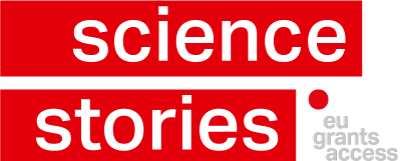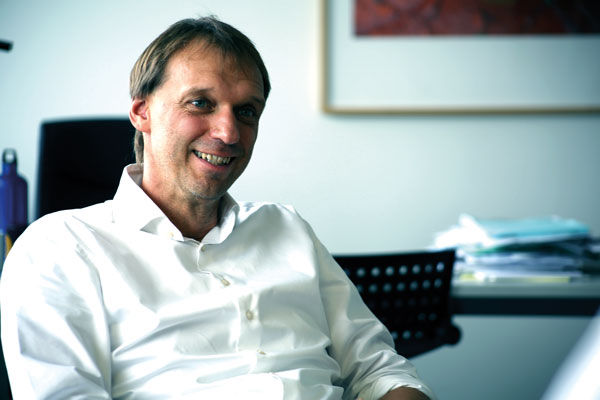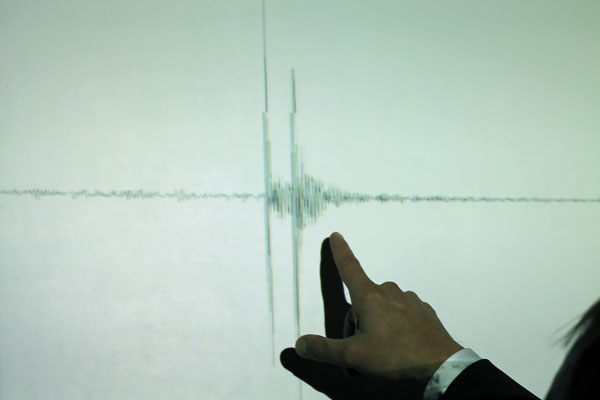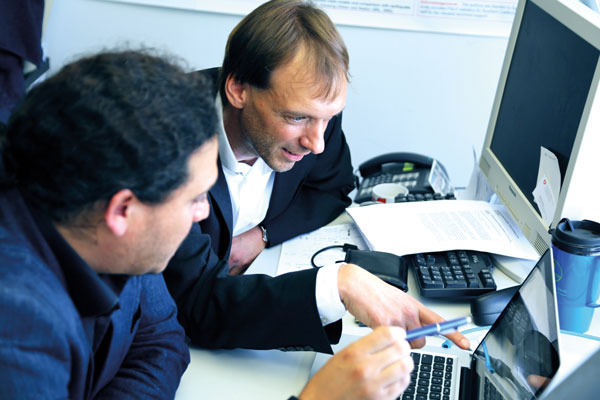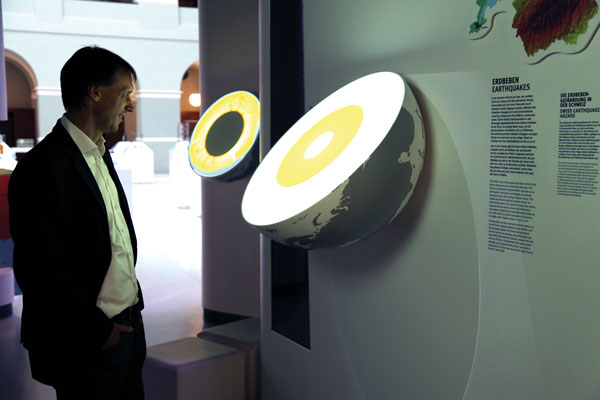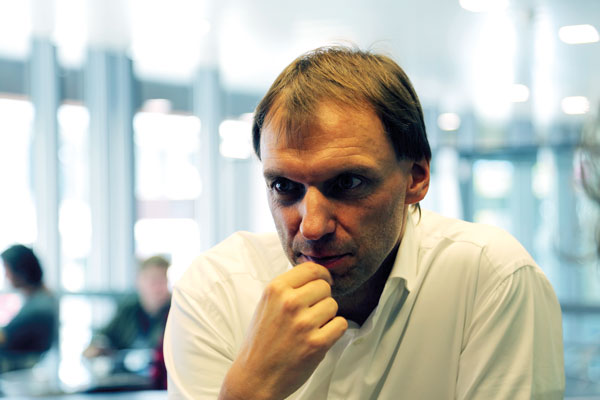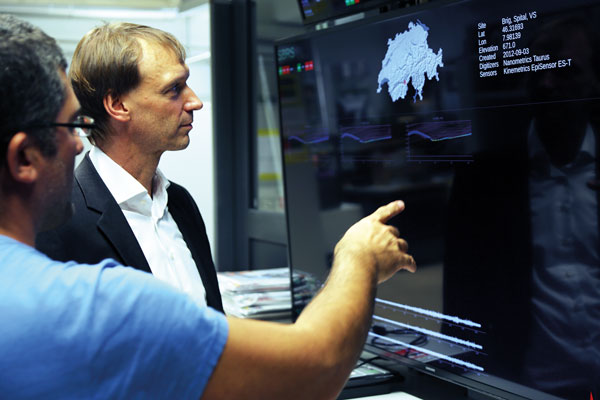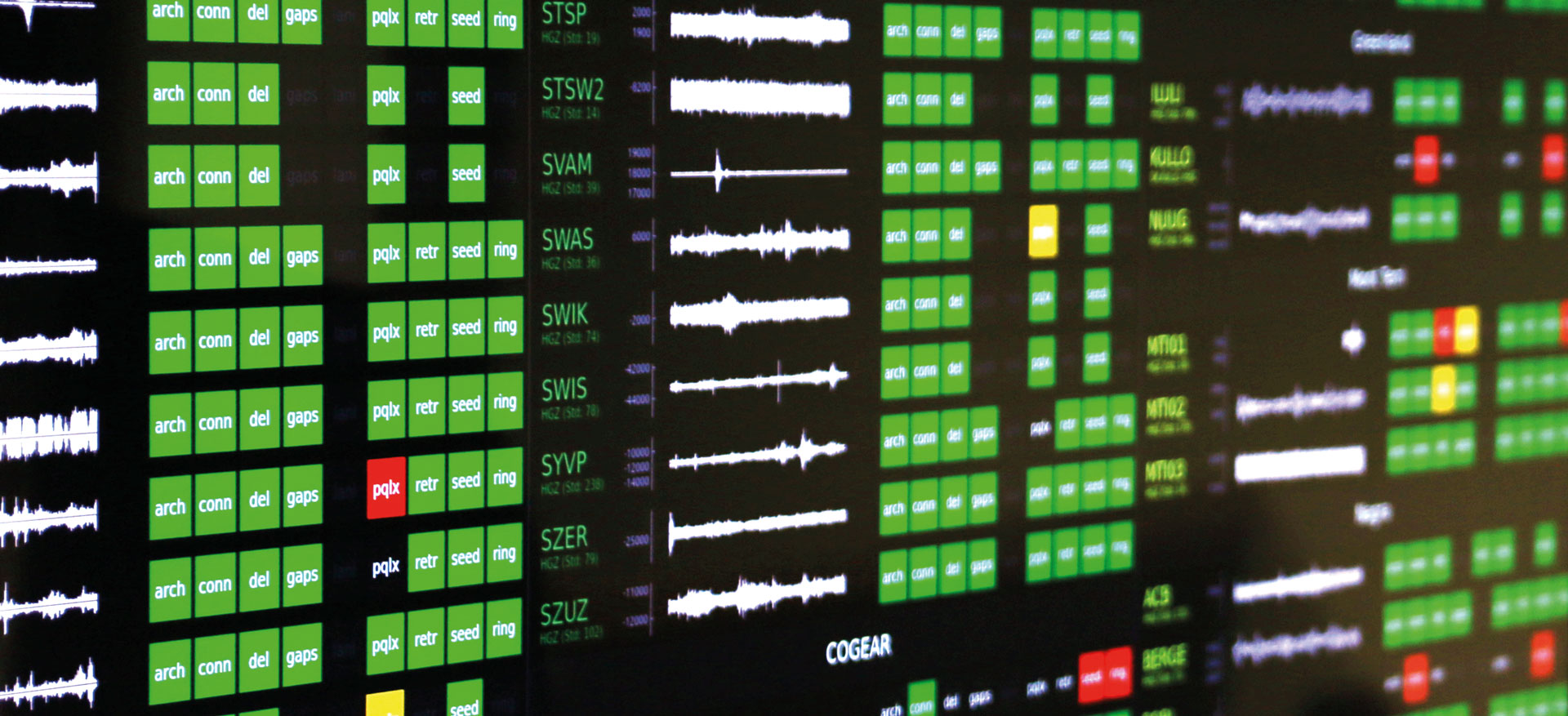
When the Earth Shakes
Understanding natural and man-made earthquakes
What fascinates Stefan Wiemer about earthquakes and his job as Director of the Swiss Seismological Service and why he wanted to be engaged in a collaborative EU project on geothermal energy.
It was a quiet Sunday morning in October 2016 up until the moment when Stefan Wiemer received the alert announcing an earthquake with a magnitude of 1.9, five kilometres beneath Basel; a small earthquake most likely not felt by the population. As the Director of the Swiss Seismological Service SED, earthquake alerts reach him quite often at any given time. More than 150 seismic stations all over Switzerland measure the slightest movements in the underground and immediately send the data to the central analysis computer in Zurich.
«For me earthquakes are
the most interesting topic.
They are so little understood
and may yet be so devastating.»
The computer screens the data for a possible earthquake and automatically generates alerts to the authorities, media and public within about 45 seconds. The computer also alerts a team of two scientists and an IT specialist who are on a 24/7 duty to oversee the monitoring of the seismic activities in Switzerland and around the world. Stefan Wiemer is informed but not always actively involved in communications, except if there is a larger earthquake like the one in central Italy in August 2016 that killed nearly 300 people. After this seismic disaster, the SED had to handle more than 40 media inquiries and the Director and members of his team gave dozens of interviews. “Media and authorities usually want to know exactly what has happened and all about the relevance the incidents have in relation to Switzerland,” Stefan Wiemer says when we meet him in his office at the Department of Earth Science at ETH Zurich.
Understanding earthquakes
Stefan Wiemer has been a passionate seismologist since his days as a student of geophysics at the Ruhr-Universität Bochum, Germany. “I became more and more fascinated by seismology because for me, earthquakes are the most interesting topic. They are so little understood and may yet be so devastating,” he says. So he devoted his research career to a deeper understanding of the mechanisms of earthquakes; why they occur, when they occur, where they occur and if they could be predicted at all. But apart from the scientific challenge he also likes the practical implications of his research field. He often sees himself as a mediator between science and the public. “What we do in research and by monitoring the underground matters greatly to people. They are fascinated by and at the same time worried about earthquakes.
«Buildings kill people, not earthquakes.
The best protection is to make
our constructions more resistant.»
We try to communicate what happens beneath the surface of the Earth in an understandable way. We also evaluate and publish the seismic hazards and give advice on how we can protect ourselves, which has a very practical meaning. I like this combination of research and service to the society very much,” Stefan Wiemer states.
The link between science and public service was reinforced after a so-called man-made earthquake that shocked Basel in December 2006. This earthquake, with a magnitude of 3.4 along with thousands of smaller ones, was induced by the Deep Heat Mining Basel project during the creation of an underground heat exchanger at a depth of five kilometres. At that time, there was great optimism in the community of Earth scientists to harvest clean geothermal energy by pumping water into the deep and heat it up down below. However, after the Basel incident and a similar one in St. Gallen many of these projects were put on hold. Ever since, the public has been reacting rather sensitively on any plans to exploit deep geothermal energy. That small earthquake near Basel on that quiet Sunday morning in October turned out to be a late reaction to the pilot drilling in 2006 – this is why Stefan Wiemer got involved personally when he received the alert and contacted several people from the local authorities.
Soft technologies for geothermal energy
Nevertheless, also in Switzerland geothermal energy has a great potential as part of the future energy mix, as it is clean and abundant. The challenge is to find technologies able to harvest the heat under our feet in a safe and sustainable way. “We are looking for soft stimulation techniques that make the heat exchange in the underground environmentally friendly, safe and sustainable in the long term,” Stefan Wiemer explains. This is precisely the objective of the EU project called DESTRESS, in which Stefan Wiemer and his team play a crucial role. Actually, he has been one of the initiators. When the call was published by the EU, he took action immediately. “I always felt it is important that Switzerland is part of such a project. We had geothermal experience in the past; we have plans for the future and are relevant players in this field. So eventually, I picked up the phone and talked to my colleagues at the Helmholtz Centre Potsdam and to Geo-Energie Suisse AG, a company focused on realising geothermal projects in Switzerland. We invited additional partners to a preliminary meeting, then we wrote a proposal and that is how the initial idea matured and became an EU project,” Stefan Wiemer recalls. DESTRESS is a large collaborative consortium that brings together science and industry on a large scale. As the focus lies much on testing and demonstrating new soft stimulation techniques at various sites, the industry assumes a strong part and communication beyond borders is quite a challenge for all of the project’s participants, as Stefan Wiemer illustrates: “When we as scientists talk about exploiting geothermal energy, we talk about induced seismicity and about risks. Industry likes to emphasise much more on the potential benefits and the costs.” Within the consortium, he and his SED communication team lead the working group “Dissemination and Communication”, ensuring that the different perceptions of operators and scientists are openly discussed and evaluated.
«When we as scientists talk about
exploiting geothermal energy,
we talk about induced seismicity
and about risks.»
Based on this information, society and authorities will weight risks against benefits and ultimately decide on new technologies. Regardless of the result thereof, DESTRESS offers a great opportunity: It enables scientists and operators to apply and closely monitor soft geothermal energy harvesting technologies, which are safe, economically liable and sustainable. “Today, we are missing a common baseline dealing with the best possible way to approach reservoir stimulation. At the closure of this project, one can at least decide whether these technologies may work. So DESTRESS is part of the solution,” Stefan Wiemer concludes.
Managing earthquake hazard
Whatever the outcome of DESTRESS, Stefan Wiemer and his team are profiting now already from participating in this project. Three additional postdocs and one communication specialist financed by DESTRESS allow Stefan Wiemer to pursue his research and to contribute meaningfully to the project. These resources would not have been sponsored by any other funding agency in Switzerland. But the true value is beyond money, as Stefan Wiemer states. “The real worth is the cooperation with partners in Europe and Asia. It enables us to exchange views and to bring our ideas and equipment to their sites and vice versa. This hopefully will accelerate the development of novel techniques and better solutions.” In future, the danger of earthquakes induced by geothermal energy projects may disappear or at least be under control. But what about the hazards of natural earthquakes? “Buildings kill people, not earthquakes,” Stefan Wiemer states. “The best protection is to make our constructions more resistant. When constructing new buildings, just a small additional investment significantly enhances earthquake safety. We just have to do it!”
Swiss Seismological Service (SED)
The Swiss Seismological Service (SED) is the federal agency for earthquakes. The SED is responsible for monitoring earthquakes in Switzerland and neighbouring countries as well as for assessing Switzerland’s seismic hazard. When an earthquake occurs, the SED informs the public, authorities, and the media about the earthquake’s location, magnitude, and possible consequences. The SED was founded in April 1914 and has been hosted at ETH Zurich since March 1957. The team of the SED consists of about sixty scientists, engineers, IT specialists, technicians, as well as communication and administrative officers.
Interview with Stefan Wiemer
Stefan Wiemer
Stefan Wiemer attained a diploma in geophysics from the German Ruhr-Universität Bochum in 1992. In 1999, after his PhD at the University of Alaska Fairbanks and his postdoc studies in Tsukuba (Japan), he joined the SED as a research associate, where he set up and led two research groups. In May 2013, Stefan Wiemer was appointed Full Professor of Seismology at ETH Zurich and Director of the Swiss Seismological Service.
Horizon 2020 - funded projects
The SED has been participating in several EU projects for more than ten years. Within the framework programme Horizon 2020, it contributes to the following projects:
DESTRESS – Demonstration of Soft Stimulation Treatments of Geothermal Reservoirs.
Objective: To test and demonstrate soft stimulation techniques that enable building a heat exchanger in the deep underground which is environmentally friendly, safe and sustainable in the long term.
Participants: A total of 16 institutions including universities, research institutes and industry companies from Europe and South Korea.
Coordinator: Helmholtz Centre Potsdam, German Research Centre for Geosciences, Germany.
http://www.destress-h2020.eu/home/
ENVRIplus – Environmental Research Infrastructures Providing Shared Solutions for Science and Society
Objective: To bring together Environmental and Earth System Research Infrastructures, projects and networks as well as technical specialist partners to create a more coherent, interdisciplinary and interoperable cluster of Environmental Research Infrastructures across Europe.
Participants: A total of 37 institutions from 13 European countries.
Coordinator: University of Helsinki, Finland.
EPOS IP – Implementation Phase of the European Plate Observing System
Objective: To create a pan-European infrastructure for solid Earth science to support a safe and sustainable society. EPOS will enable innovative multidisciplinary research for a better understanding of the Earth’s physical and chemical processes that control earthquakes, volcanic eruptions, ground instability, tsunami, and all those processes driving tectonics and Earth’s surface dynamics.
Participants: A total of 47 institutions from 23 countries.
Coordinator: Istituto Nazionale di Geofisica e Vulcanologia, Italy.
